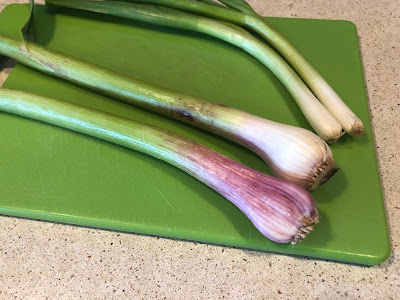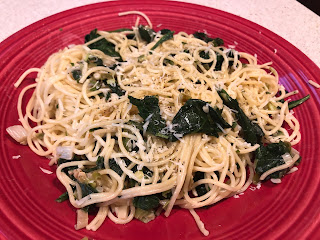
Recipe: Pasta with green garlic and baby spinach
 |
|
Green garlic stalks, foreground, look similar to scallions, in back, and can be
used in similar ways. (Photos: Kathy Morrison)
|
Spring brings so many wonderful vegetables into the farmers markets, but some of them have a short season, so I try to enjoy them while I can.
One of those is green garlic, which is simply garlic harvested before the cloves have fully formed and while the tops are still green.
In the market, the stalks look like overachieving scallions, maybe with a slightly more bulbous end, depending on when it was harvested. The stalks can be chopped or minced to be used like scallions, too, but with a creamier garlic flavor. As a bonus, the papery skin hasn't formed on the cloves yet, so there's no peeling required.
The recipe here makes use of that lovely garlic flavor -- much milder than an equivalent amount of regular garlic would be. (You might not be able to scare off any vampires with it, however.) It is very loosely based on a New York Times dish, one of several pasta recipes they've printed that celebrate spring vegetables. There's not a tomato in any of them -- all very green.
This cooks quickly, so it's best to have all the ingredients chopped and ready before you start.
A note about anchovy paste: It's made from fish, sure, but won't add a fishy taste to the pasta. It mellows the other ingredients and lends the dish umami, the savory "fifth flavor" that chefs love. To make this dish vegetarian, substitute 4 dried porcini mushrooms, plumped with a couple tablespoons hot water, and then minced. You might need to add a little extra salt, too.
Pasta with green garlic and baby spinach
Serves 4
Ingredients:
Kosher salt
8 ounces thin spaghetti or linguine
2 tablespoons olive oil, divided
2 teaspoons anchovy paste, or 4 anchovy fillets, finely chopped
2 large or 3 smaller stalks green garlic, trimmed and chopped, including most of the green part
2 scallions, chopped
2 tablespoons flat parsley, chopped
1/4 teaspoon crushed red pepper flakes, or to taste
2 to 3 tablespoons half and half, heavy cream or vegetable broth
5 ounces baby spinach leaves, about 7 cups
Juice of 1/2 lemon
Ground black pepper, to taste
1/4 cup grated Parmesan cheese, or to taste, optional
Instructions:
Bring 4 quarts of water to boil in a large pot. Add 1/2 teaspoon of salt, then the pasta, stir, and cook until almost al dente. Reserve 1/2 cup cooking water, then drain the pasta briefly, and return it to the cooking pot off the heat.
 |
| Spring flavors blend in this easy pasta dish. |
While the pasta is cooking, heat 1 tablespoon olive oil in a large sauté pan. Stir the anchovy paste into the warm oil, then add the garlic, scallions, parsley and red pepper flakes. Cook over medium-high heat for no more than 3 minutes. Add the remaining olive oil. Turn down the heat to medium and gently stir in the half and half, cream or broth. Add some of the cooking water if the mixture is still pretty thick -- the consistency should be closer to sauce than paste.
Pile the spinach leaves on top of the mixture in the pan, then squeeze the lemon juice over the leaves, and grind some black pepper over it all. Stir until the spinach is wilted, 1 to 2 minutes.
Add the cooked pasta to the pan, stirring, for about 1 minute. Sprinkle Parmesan over all, if using, and some more ground pepper. Serve immediately.
Comments
0 comments have been posted.Sacramento Digs Gardening to your inbox.
Food in My Back Yard Series
April 22: Should you stock up on fertilizer? (Yes!)
April 15: Grow culinary herbs in containers
April 8: When to plant summer vegetables
April 1: Don't be fooled by these garden myths
March 25: Fertilizer tips: How to 'feed' your vegetables for healthy growth
March 18: Time to give vegetable seedlings some more space
March 11: Ways to win the fight against weeds
March 4: Potatoes from the garden
Feb. 25: Plant a fruit tree now -- for later
Feb. 18: How to squeeze more food into less space
Feb. 11: When to plant? Consider staggering your transplants
Feb. 4: Starting in seed starting
Sites We Like
Garden Checklist for week of April 27
Once the clouds clear, get to work. Spring growth is in high gear.
* Set out tomato, pepper and eggplant transplants.
* From seed, plant beans, beets, cantaloupes, carrots, corn, cucumbers, melons, pumpkins, radishes and squash. Plant onion sets.
* In the flower garden, plant seeds for asters, cosmos, celosia, marigolds, salvia, sunflowers and zinnias. Transplant petunias, zinnias, geraniums and other summer bloomers.
* Plant perennials and dahlia tubers for summer bloom. Late April is about the last chance to plant summer bulbs, such as gladiolus and tuberous begonias.
* Transplant lettuce and cabbage seedlings.
* Weed, weed, weed! Don’t let unwanted plants go to seed.
* April is the last chance to plant citrus trees such as dwarf orange, lemon and kumquat. These trees also look good in landscaping and provide fresh fruit in winter.
* Feed citrus trees with a low dose of balanced fertilizer (such as 10-10-10) during bloom to help set fruit. Keep an eye out for ants.
* Apply slow-release fertilizer to the lawn.
* Thoroughly clean debris from the bottom of outdoor ponds or fountains.
* Start thinning fruit that's formed on apple and stone fruit trees -- you'll get larger fruit at harvest (and avoid limb breakage) if some is thinned now. The UC recommendation is to thin fruit when it is about 3/4 of an inch in diameter. Peaches and nectarines should be thinned to about 6 inches apart; smaller fruit such as plums and pluots can be about 4 inches apart. Apricots can be left at 3 inches apart. Apples and pears should be thinned to one fruit per cluster of flowers, 6 to 8 inches apart.
* Azaleas and camellias looking a little yellow? If leaves are turning yellow between the veins, give them a boost with chelated iron.
* Trim dead flowers but not leaves from spring-flowering bulbs such as daffodils and tulips. Those leaves gather energy to create next year's flowers. Also, give the bulbs a fertilizer boost after bloom.
* Pinch chrysanthemums back to 12 inches for fall flowers. Cut old stems to the ground.
* Mulch around plants to conserve moisture and control weeds.